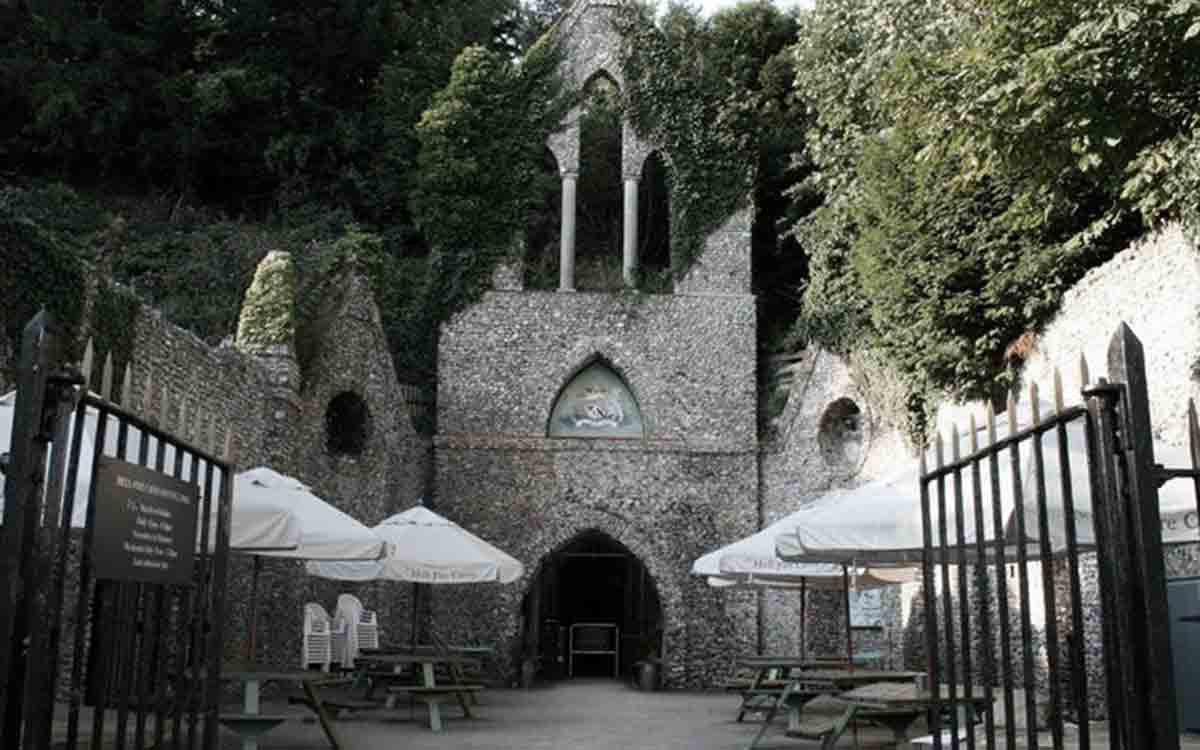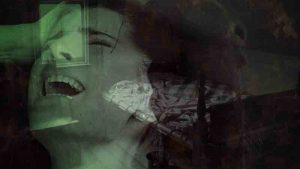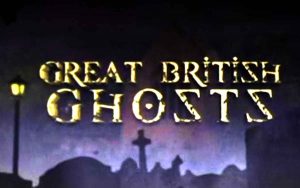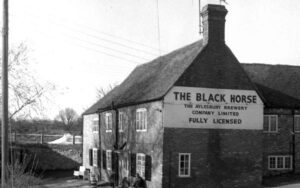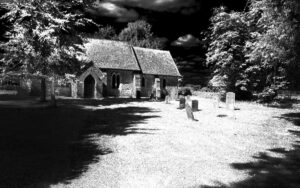EDDIE BRAZIL reveals the dark history, horrors and ghosts of West Wycombe in Buckinghamshire
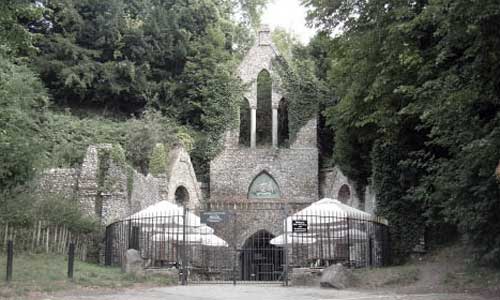
The village of West Wycombe lies some two and a half miles from the centre of High Wycombe along the A40 some 35 miles north-west of London.
It is a pleasing location containing many fine half-timbered buildings dating from the 15th to 18th centuries, and even though today it is somewhat marred by the traffic which thunders along its high street, the alleys, lanes and courtyards off the main thoroughfare still retain an air of quiet calm.
Yet, it is here, in this rural charm, that ghosts, murder, pagan worship and the debauchery of 18th century titled gentry are all inextricably linked with this seemingly, peaceful English village.
West Wycombe could well be described as a place perfect for ghosts and the mysteries of Britain’s pagan past.
The hilltop parish church, dedicated to St Lawrence, the patron saint of prostitutes stands within the ramparts of an iron age hill fort.
The site has been continuously occupied for thousands of years. A bronze age settlement is widely believed to have first existed on the hill, and research has shown that a Pagan temple was constructed in a similar style to Stonehenge.
The Romans also built their own settlement and religious temple here. The hill retained its religious importance and the first Christian church was erected in 635AD.
With such an ancient and dark past it seems appropriate that the one man who would become Lord of the Manor at West Wycombe took eagerly to the pleasures, rituals and rakish delights of 18th-century decadence.
Sir Francis Dashwood and the Hellfire Caves
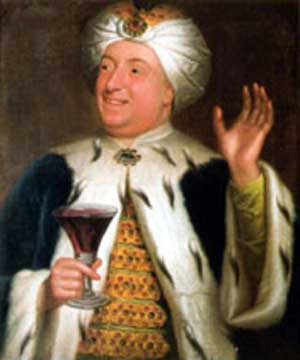
In 1724, Sir Francis Dashwood (1708-1781), 2nd Baronet, and later 15th Baron le Despencer succeeded to the estate and set about remodelling the house, West Wycombe Park.
Like many titled gentlemen of his day, he embarked on the grand tour of Europe and returned to England with his own grandiose plans for West Wycombe.
In 1751 the 14th-century church of St Lawrence disappeared within Dashwood’s rebuilding of the interior copied on the 3rd-century temple of the sun at Palmyra near Damascus.
Only the medieval tower was retained, which itself was considerably heightened and topped by a great golden ball fitted with benches, and large enough to contain six people.
It was in the golden ball that Dashwood and his cronies drank the night away as they played cards and related bawdy stories.
Yet, of all Sir Francis grand schemes for West Wycombe perhaps the most ambitious was undertaken between 1748 and 1752 with the extension of a series of ancient chalk tunnels under West Wycombe hill into an elaborate labyrinth of caves and chambers.
The Caves design were much inspired by Dashwoods travels in the Mediterranean.
The descent through the passageways and underground chambers concluded by crossing a subterranean river named the Styx and entering into the inner temple which is said to lie directly 300 feet below the church of St Lawrence.
According to Greek mythology, the River Styx separated the mortal world from the immortal world, and the subterranean position of the Inner Temple directly beneath Saint Lawrence’s Church was supposed to signify Heaven and Hell.
The Hellfire Club
Between 1750 and 1766 what would become known as The Hellfire Club held their nefarious meetings in the caves below the hill. Here they called themselves the Brothers of St Francis, and their numbers included artist, William Hogarth, political activist, John Wilkes, John Montague, 4th Earl of Sandwich, Poet, Paul Whitehead and possibly, at times, American, Benjamin Franklin.
They greeted each other as Brother and dressed as monks, while their accompanying ladies were attired as virginal nuns. They are said to have conducted Satanic or pagan rituals and indulged in drinking, gambling and whoring.
The Hellfire Club disbanded in recrimination in 1766 following a practical jape played on the Earl of Sandwich during one of their drunken ceremonies, and his subsequent ridicule for believing that the materialisation of a monkey, jokingly released from a box by a fellow member, was the manifestation of the Devil.
Following Dashwood’s death in 1781, the caves fell out of use and became derelict. It was in the early 19th century that the subterranean passageways and West Wycombe hill became the site of reported ghostly phenomena.
The spirit Paul Whitehead, a steward and secretary of the Hellfire Club and close friend to Sir Francis Dashwood is believed to haunt the caves.
The apparition of a man in 18th-century clothing has been reported roaming the caves and also ramparts of the iron age hill fort which surrounds the Dashwood Mausoleum.
A young girl visiting the caves became separated from her friends and found her self alone in a deep part of the labyrinth.
Not seeing or hearing any other person, she began to feel lost and frightened.
The atmosphere within was changing, becoming cold and dim.
Feeling that she must find her way to the exit, she quickly returned along a passageway which seemed to ascend towards the entrance.
She had only gone a short distance when she became aware that someone was following her.
Turning, she saw the figure of a man in 18th-century clothing standing some distance away staring at her.
As they faced each other, the young woman said she felt in no way threatened by the man, and assumed he was one of the caves living history guides.
Yet, as she looked the figure gradually faded away.
‘Suki’ the ghost of George and Dragon Pub
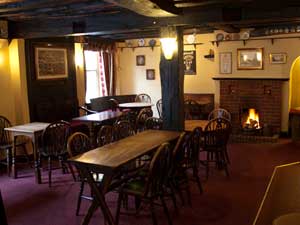
Perhaps the most well known, and frequently sighted ghost to walk the caves, and the George and Dragon pub in the village is that of Suki, an attractive 16-year0old barmaid employed at the pub during the late 18th century.
It was said that she fell for the charms of a Gentleman who was passing through the village, much to the annoyance of three local lads who also had their eye on the pretty serving girl.
A message, purporting to be from the handsome Gentleman, was sent to Suki at the tavern instructing her to meet him in the caves at night.
Dressed in her finest white dress she entered the caves only to find that the message had been a hoax planned by the three jealous boys. In anger, she threw rocks at the laughing lads.
When the boys responded by throwing back Suki was knocked unconscious. She was secretly brought back to her room at the inn but the next morning was found dead.
Her ghost is said to walk the corridors of the George and has also been reported to glide across the garden.
In 1967 an American tourist staying at the George was intrigued by the story of the ghostly barmaid and wanted to sleep in the haunted room.
Partway through the night he awoke with a start as icy hands were placed on his forehead.
When he turned on the lamp the feeling went away and the room was empty.
Then he noticed a pinpoint of light near the door. As he watched it grew in length and width.
It had a strange, opaque, pearly quality and would vanish when he switched the light on, only to reappear when he turned it off.
Plucking up courage he went over to the light, but as soon as he reached it he felt the most intense cold, he couldn’t breathe and his limbs felt heavy.
Suddenly the illuminated form moved towards him and he leapt back in terror onto the bed turning on the light as he did so.
At once the strange shape vanished.
So much was the tourists fear at what he had experienced he slept no more that night and left early the next morning vowing never to spend another second at the George.
The spectre of Suki has also been seen looking from the windows of the inn waiting and pining for her lost love.
In the early 1990s, the landlady of the George entered one of the rooms and saw the apparition of a young woman with a sad, lost expression sitting by the fire.
After a few moments, the ghost turned to look at the landlady and then slowly faded away.
The phantom barmaid is not the only ghost said to walk the rooms and corridors at the pub.
Disembodied footsteps which have been heard descending the main staircase are believed to be the spirit of a visitor to the inn who was robbed and murdered in his room during the 18th century.
Haunted West Wycombe hill
The paranormal activity at West Wycombe is not only confined to the George and Dragon pub.
In 1995 five teenage girls were camping near woodland on West Wycombe hill.
At about one o’clock in the morning, they were awoken by the sound of what they described as howling which seemed to surround the tent.
The Girls listened terrified as the strange, guttural cry continued for several minutes before suddenly stopping.
Yet, their frightening ordeal had not ceased, as following the sound of howling the tent was lit up by flashing lights which shorn from outside.
Although extremely alarmed at what was happening, two of the teenagers plucked up enough courage to pull back the flaps and peered outside.
At once the flashing lights were extinguished and the hill was in darkness.
All the girls now frantically exited the tent to see what was going on, yet, as they did so, the terrifying howling once again started up, but there was nothing to account for the noise.
The strange sounds continued for a few seconds and again abruptly ceased.
Yet, as the trembling teenagers clung to each other for comfort, their ordeal was to climax in a terrifying vision.
At once all heard the approaching heavy thud of a horse in full gallop.
To the young women’s astonishment and terror from no where appeared the apparition of a headless man riding a white horse which sped across the field close to where they stood.
The girls watched open-mouthed as the horse and rider continued up the hill.
Yet, even though they could hear the sounds of hooves on earth, the white horse seemed to be galloping a metre above the ground. Just as quickly as the speeding horse had appeared it vanished into the darkness, and the sound of the hooves faded away.
The experience was to much for the five teenagers and they speedily broke down their tent and fled.
There is a tradition at West Wycombe that on moonlit nights the ghost of Sir Francis Dashwood rides up the hill on a brilliant white charger.
Unlike the rider experienced by the five teenagers, Sir Francis is not without his head as he gallops towards the church of St Lawrence.
Another phantom which has been reported wandering West Wycombe hill and the ramparts of the ancient iron age fort is believed to be that of Paul Whitehead It is said that his ghost haunts the woods surrounding West Wycombe Park.
The spectre has been seen waving and beckoning from the trees, and also observed outside the house.
When Sir Francis Dashwood died in December 1781, the ghost of Whitehead was no longer seen.
West Wycombe House is also not without its ghosts.
The music room is said to be haunted by a lady in white who is thought be the Grandmother of Sir Francis Dashwood.
The ghost of a phantom monk has also been seen in the room.
When celebrated playwright and songwriter, Noel Coward was staying at the house he gave a recital in the music room.
As he played the piano he saw the figure of a smiling monk watching him. With typical nonchalance and the least hint of alarm, Coward continued his song to the end, where after the smiling, and no doubt appreciative, brother disappeared.
Smiling Monks, headless horsemen, ladies in white and phantom barmaids, West Wycombe would seem to have them all.
The Ghostly Gropers of the Hell Fire Caves
(Articles originally published on Spooky Isles on 2 December 2018.)
A prudish spinster had a life-changing experience after being attacked by the Hell Fire Caves’ randy ghosts, EDDIE BRAZIL reports
In the early 1980s, a lady friend of the Dashwood family was visiting West Wycombe Park in Oxfordshire, and asked if she could see the infamous Hell Fire Caves.
The 60-year-old spinster was so keen to see where Sir Francis Dashwood – the originator of the Hell Fire Caves – and his cronies had enjoyed their drunken orgies.
She had been told of the ghosts and phantoms which were said to wander the passageways of the labyrinth.
She dismissed this obvious attempt to dissuade her from entering the caves and brushed it aside with a laugh. She added that she would walk the darkened passages alone armed only with a torch. She was, by all accounts, a fiery woman not given to flights of fancy.
She had remained unmarried and had always eschewed the company and pleasure of many male admirers. In fact, it seemed she was something of a prude.
Hell Fire Caves and deprave sexual practices
As the lady proceed in to the caves she soon reached what is known as the banqueting hall; a vast cavern carved out of the chalk and used by the members of the Hell Fire Club for their drunken dinners.
It was also the place where the members practised their “devotions” with their female companions.
As the fearless spinster looked about her she had a most, and one might say, life-changing experience.
In the shadowy dark, and without warning, she says she had the unmistakable sensation of countless invisible hands touching, caressing and fondling her body in a most amorous and sensual fashion.
From head to foot the unseen hands explored her plump, curvy figure, probing in places which the good lady had never before been prodded.
Terrified, she at once fled shrieking from the chamber and back to the exit.
Never again would she venture in to such an evil, immoral and Godless place.
However, some years later, it became known to the Dashwoods that following the spinster’s frightening, but sensual, encounter in the caves, a change had come over her.
Whether it was the randy attentions of the ghost of Sir Francis Dashwood, or the drunken lecherous groping of his phantom disciples, we will never know
But totally out of character, the spinster decided to thrust off her prudish shackles and disdain for the pleasures of the flesh, and began to court the friendship and pleasure of male companions.
Three score years of celibacy were abandoned as a dormant sexual awakening burst in to life and she became a raving nymphomaniac.
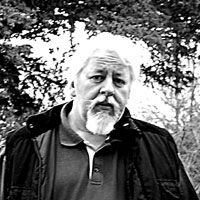
EDDIE BRAZIL was born in Dublin in 1956. He is a writer, photographer and paranormal investigator. He is co- author, with Paul Adams and Peter Underwood, of The Borley Rectory Companion and Shadows in the Nave: A Guide to the Haunted Churches of England. In 2012, with Paul Adams, he co-wrote Extreme Hauntings: Britain’s Most Terrifying Ghosts, and in 2013 he published the first ghostly guide to his hometown Haunted High Wycombe. He has recently completed a bloody history of Buckinghamshire, which will be published in November. He is also a guitarist, and in 1983 wrote the theme music to the British comedy movie,”Expresso Splasho” which featured Gary Oldman and Daniel Peacock. Eddie lives with his wife and Daughter in Hazlemere, Buckinghamshire. Find out more at his website here.

